Pull-ups are pound-for-pound one of the best exercises you can do! Learn the full range of benefits of pull-ups, from strengthening the upper body muscles to improving posture and functional fitness.
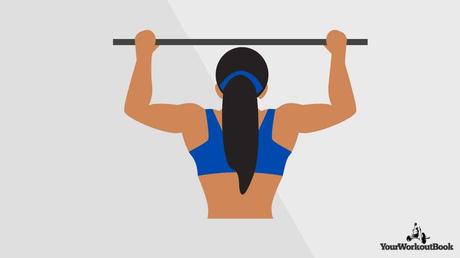
Pull-ups are a classic upper-body strength training movement that targets the back, shoulders, arms, and other supporting muscles. It’s pound-for-pound one of the best bodyweight exercises on the planet.
The benefits of pull-ups include strength development (particularly the back, arms, and shoulders), building muscle, increased grip strength, and it can be modified for different fitness levels.
In this article, we are going to do a deep dive into all the benefits of doing pull-ups, exploring how this old-school exercise can help you unlock your full potential in the gym, whether that means building a huge back, improving athletic performance, or simply doing your first unassisted pull-up.
Let’s jump right in.
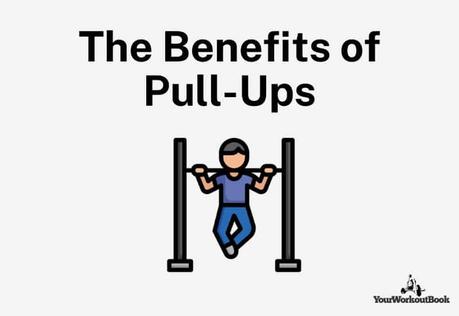
- Pull-ups are excellent for building strength
- Muscle Building
- Improved grip strength
- Pull-ups are a safe overhead exercise
- Lots of progressions for beginners
- Progressions for more advanced lifters, too
- Versatility
- Minimal equipment
- Highly functional exercise
#1. Pull-ups are excellent for building strength
One of the primary benefits of pull-ups is that they are an excellent exercise for building overall upper body strength.
After all, what could be a better expression of power and strength than shooting yourself into the sky against the wishes of gravity!
There is a vast body of research that shows the benefits of building more strength, from increasing self-confidence (Talepasand et al., 2016), and boosting mood (Gordon et al., 2017) to improved athletic performance (Seitz et al., 2014).
Pull-ups are one of the best upper body exercises for developing overall strength. They are a closed-chain, compound exercise that requires multiple muscle groups and joints working together, leading to greater muscle recruitment and activation.
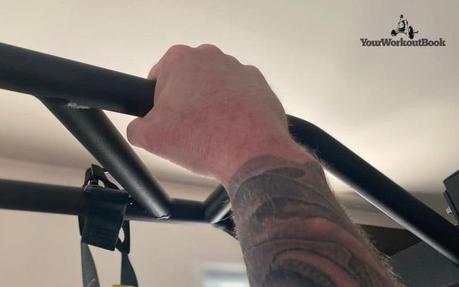
This makes the pull-up superior to many classic back exercises, such as lat pulldowns, dumbbell rows, and inverted rows.
Pull-ups are a compound, closed-chain exercise that requires multiple muscle groups and joints working together, leading to greater muscle recruitment and activation.
This means they can outperform classic back exercises such as lat pulldowns and inverted rows.
A study published in the Journal of Physical Fitness, Medicine and Treatment in Sports (Hewit et al., 2015) showed that pull-up significantly outperformed another classic back pull exercise, the lat pulldown.
Pull-ups were better for developing strength when it come to the latissimus dorsi, biceps brachii, trapezius, and the rectus abdominis.
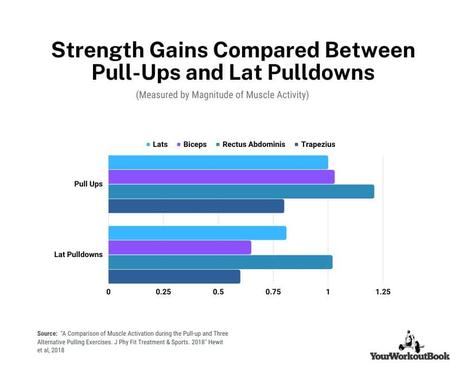
In order to get the strength-developing benefits of pull-ups, remember to do the proper number of repetitions to stimulate strength growth.
According to scientists at CUNY Lehman College and the Institute for Health and Sport, Victoria University (Schoenfield et al., 2021), the range for strength development is 1-5 repetitions of 80-100% effort.
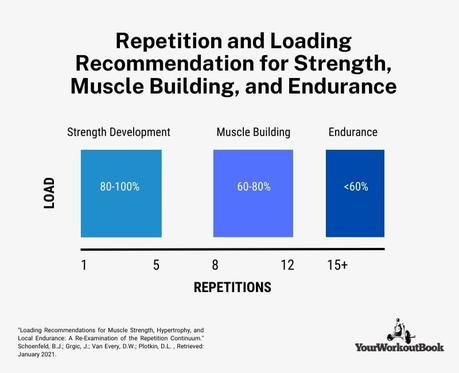
If your goals with pull-ups are not mainly strength but hypertrophy (muscle building—which we will cover indepth shortly), aim for a repetition range between 8 to 12 repetitions using 60% to 80% of your one-rep maximum.
Pull-ups are an excellent tool for developing upper body strength.
Remember to be consistent in the gym, use progressive overload, and proper technique, and you will see significant increases in overall strength in due time.
#2. Pull-ups build muscle
One of the advantages of incorporating pull-ups into your workout routine is that they work a broad range of muscles in the upper body, with the latissimus dorsi and other back muscles being the primary muscles worked.
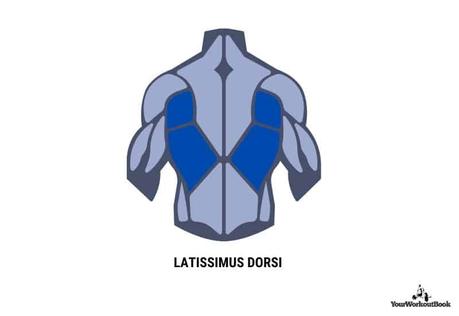
Muscle development with pull-ups also focuses heavily on the biceps brachii and infraspinatus muscles.
A study published in the Journal of Strength Conditioning Research (Youdas et al., 2010) showed just how dominant the lat muscles are during pull-ups.
According to EMG analysis, the lats produced 120% of maximum voluntary isometric contraction (MVIC) when doing pull-ups, in comparison to the next most contracted muscle group, the biceps at approximately 80% MVIC.
Pull-ups are a highly effective exercise for building muscles in the back, shoulders, arms, and core.
#3. Pull-ups improve grip strength
Grip strength refers to the ability to exert force with the hand and fingers. Whether you are wrapping your fingers around a barbell to perform a heavy lift or trying to open a can of your favorite strawberry jam, grip strength plays a huge role in our daily lives.
Pull-ups are an exceptionally effective exercise for building grip strength on top of building back and arm muscles.
From the beginning of the exercise, when you wrap your fingers around the bar, to stabilizing your body to keep it from swinging, to the vertical pulling motion, the grip is being taxed and challenged.
A meta-analysis published in the Journal of Clinical Interventions in Aging revealed a strong correlation between grip strength and various positive health outcomes (Bohannon, 2019).
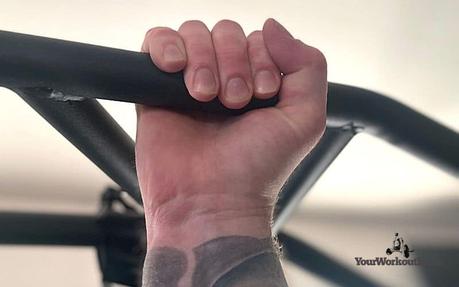
These include improved overall strength, increased bone mineral density, reduced risk of falls and fractures, decreased depression, and enhanced quality of life.
Grip strength is the weakest link in the kinetic chain when it comes to pulling lifts, whether performing a heavy deadlift or doing pull-ups.
Adding more pull-ups to your workout routine will help to improve grip strength, accelerating improvement across your other lifts.
Advanced users who want to really take their grip strength to the next level can add a thick bar grip to widen the bar, making it more challenging to grip.
#4. Pull-ups are a safe overhead exercise
Pull-ups are one of the safest overhead exercises lifters can do in the gym or home.
Pull-ups are generally safe for the shoulder joint when done with proper technique (the golden rule when strength training!).
Fun Fact: Lifters who want to improve stability in the shoulder girdle and rotator cuff should focus on pull-ups.
A paper published in the Scandinavian Journal of Medicine and Science (Urbanczyk et al., 2020) found that pull-ups (palms facing away) elicited a higher degree of muscle recruitment in the shoulder joint and the rotator cuffs compared to front pull-ups or wide-grip pull-ups.
That is in addition to pull-ups being very safe to ditch when failing a rep, on purpose or otherwise.
Unlike other overhead lifts like shoulder or military presses, no loaded barbell or dumbbell can fall on your head, shoulders, and back should you fail or have to ditch a rep.
In a study published in the American Journal of Sports Medicine (Kerr et al., 2010), researchers analyzed the total number of hospital visits in the United States due to weight training between 1990 to 2007.
By far, the leading cause of trips to the emergency department, a whopping 65.5%, was from weights dropping on individuals.
Among these injuries where the types of gym equipment were known, free weights represented a significant number of injuries (90.4%).
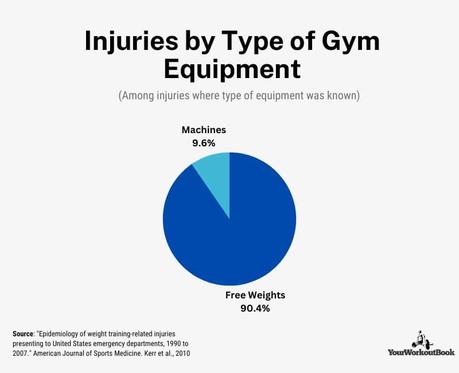
Because pull-ups are fundamentally a bodyweight exercise, including them in your workout routine gives you the advantage of using one of the safest overhead exercises for building upper body muscle and strength.
#5. Lots of regressions for beginners
Performing pull-ups are not always easy, especially for beginners.
How many pull-ups a person can do comes down to body mass, muscle strength, and proper form.
Fortunately, for the newbie lifter who can’t quite nail that first technically proficient pull-up, there are lots of pull-up regressions to choose from, including:
Pull-up holds. Static holds on the bar—jump up so that your chin is in line with the bar—for 5-10 seconds improves overall stability and strength.
Pull-up hangs. Similar to top-of-bar holds, pull-up hangs help improve shoulder stability and build grip strength.
Pull-up assist bands. While lat pulldowns are comparable to pull-ups, doing pull-ups with assist bands is a more specific way to improve pull-up technique and strength.
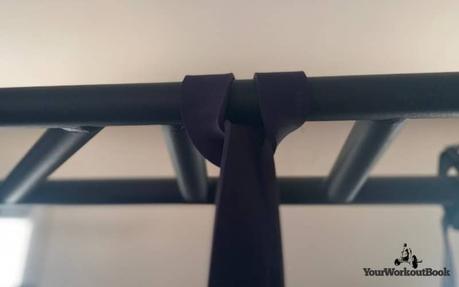
Interestingly, a study published in the Journal of Physical Fitness, Medicine and Treatment in Sport (Hewit et al., 2018) showed that latissimus dorsi activation was much higher when doing assisted pull-ups compared to lat pulldowns.
Just because you can’t do that first pull-up perfectly (yet!), that doesn’t mean you cannot take advantage of the vast number of benefits of pull-ups.
#6. Progressions for more advanced lifters
Mastering the pull-up doesn’t stop when you can complete several unassisted pull-ups—there are plenty of excellent progressions you can use to keep the gains and improvement coming.
Unlike a standard gym machine which offers limited grip and progression options, one of the benefits of a pull-up is that there are TONS of ways to make the exercise more challenging.
The main progression for the advanced lifter is weighted pull-ups. Wrap a dip belt around your waist, clip it to a weight plate (or two!), and increase the resistance.
Fun Fact: The most pull-ups completed in a 24-hour period is a whopping 7,479 reps. The record was set by 60-year-old Graham Morgan in Portugal in the fall of 2022.
This is perfect for advanced lifters who want to stay in the “strength development” repetition range or who are getting so proficient at pull-ups that they are cruising past the benchmarks for the hypertrophy range (8-12 reps).
Other advanced pull-up progressions include wider grip pull-ups (which really fire up the lats), towel-pull ups, one-armed pull-ups, narrow grip pull-ups, and more.
No matter how good you get at pull-ups, there is a progression to challenge you and help you improve and get stronger.
#7. Pull-ups are a versatile upper-body workout
Although the pull-up looks insanely simple—pull up, go down, repeat), one of the key benefits of pull-ups is how versatile the ressitance training exercise can be.
By changing grip, bar thickness, and other variations, you can use the pull-up to target different muscle groups and accomplish your specific workout goals.
One study, “Avoiding high-risk rotator cuff loading: Muscle force during three pull-up techniques,” by researchers at the Imperial College in London (Urbancyzk et al., 2020), examined the peak muscle force between three different pull-up grips.
Some of the highlights include:
- Chin-ups solicited more engagement in the biceps compared to pull-ups or wide-grip pull-ups
- Pull-ups generated the most amount of muscle recruitment compared to chin-ups or even wide-grip pull-ups
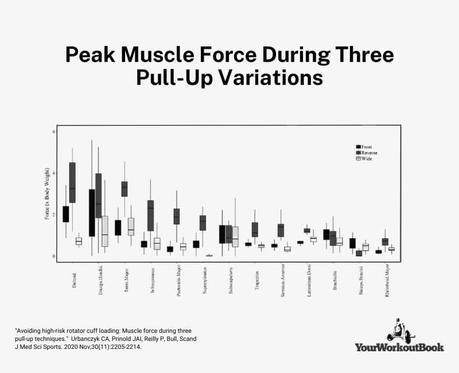
No matter what your goals in the gym, or which muscles you would like to focus on in the upper body, there is a pull-up variation that you can use to get stronger.
#8. Minimal equipment required
Pull-ups are a bodyweight exercise requiring solely a weight-bearing horizontal bar.
Combined with push-ups, pull-ups are the ultimate no-frills upper body workout that requires nearly no equipment.
No gym membership required. No large weight machines. No expensive equipment.
There are plenty of inexpensive doorway pull-up bars, free-standing pull-up bars, and even outdoor pull-up bars that can be erected at home.
These are a cost-effective way to do pull-ups in the comfort of your own home and many options include multiple grips for grip variety.
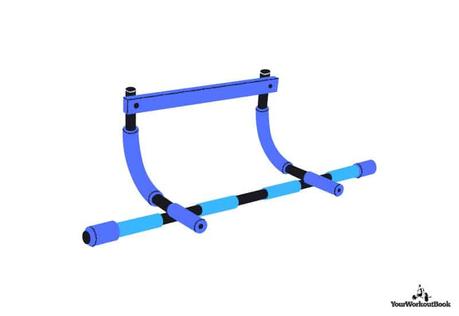
Additionally, many squat racks have pull-up bars should you choose to go the route of building out a home gym of your own.
One of my favorite benefits of pull-ups is that you can do them anywhere, anytime, with a one-time investment of around $30 or so.
#9. Pull-ups are a highly functional exercise
Functional exercises refer to movements that carry over to the improvement of everyday tasks and activities.
While big muscles and more strength are great, pull-ups also run the added benefit of being a highly functional exercise.
Here are just some of the benefits of pull-ups as they relate to real-life scenarios of functional strength:
Added grip strength – Open cans easier, carry more groceries from the car (i.e. ALL of them

Core strengthening and better posture – The pull-up is an upper body exercise that requires a ton of core stability, building overall stability, helping you better lift objects. Enchanced core stability improve posture, making pull-ups an excellent exercise for slouchers and people who sit all day at work.
Pulling – Pull-ups are fundamentally a pulling movement, which mimics other patterns in real life, from opening doors, pulling a box down from the top shelf in the garage.
And of course, all of these functional benefits also carry over to the other big pulling exercises in the gym, including deadlifts and rows.
Benefits of Pull-Ups – Frequently Asked Questions
Here are some common questions I get about the benefits of pull-ups and how to incorporate them into a workout routine:
What muscles do pull ups work?
Pull-ups are primarily an upper body exercise that target, in order, the latissimus dorsi (lats), biceps brachii (biceps), trapezius, rhomboids, deltoids, and the forearm.
Pull-ups are also a very effective core exercise, targeting the obliques and the full range of rectus ambdominus muscles (your “six pack”).
Depending on the grip of the pull-up, they can also engage muscles in the chest.
Although pull-ups activate the lats hardest, they are in the truest sense of the word a full upper-body resistance training exercise.
How to do more pull ups?
Increasing the number of pull-ups you can do requires practice, consistency, and using regressions and progressions to improve strength on the pull-up bar.
Here are some quick tips for doing more pull-ups:
Start with assisted pull-ups to master technique and muscle activation – banded pull-ups are an excellent way to learn the proper movement and firing of muscles to execute an efficient pull-up.
Use holds, dead-hangs and negatives to build strength – These regressions are key in building the strength required to perform pull-ups properly.
Engage the core – One of the key mistakes I see with clients mastering the pull-up is a “wet spaghetti” core when lifting. Brace the core to maximize force.
Use progressions to master the pull-up – Once you can do 5-8 reps comfortably, progress to weighted pull-ups, towel pull-ups, one-arm pull-ups.
What are the benefits of different pull-up grips?
Pull-ups can be performed using a variety of different grips. Each pull-up grip targets different muscle groups and offers distinct biomechanical advantages.
The most common pull-up grips include:
Overhand grip – This is the classic pull-up grip, also known as pronated grip, where the palms face away from you. Best used for lat development and shoulder stability.
Underhand grip – Also known as a chin-up, this pull-up grip variation is a monster for targeting the biceps and the muscles along the front of the shoulder capsule.
Neutral grip – Neutral grip pull-ups, where the palms face each other at shoulder-width, are easier on the elbows and shoulders and are an excellent option for people progressing towards overhand grip pull-ups.
The Bottom Line
The pull-up is one of the kings when it comes to the gym, whether it’s your local bog box gym or home gym.
By engaging a wide swath of muscle groups in the back, arms, shoulders, and core, pull-ups are an essential resistance exercise that promotes strength, muscle development and functional fitness.
For those intimidated by the exercise, start with regression exercises like inverted rows, dead-hangs, and negatives.
For more experienced lifters, consider weighted pull-ups, towel pull-ups, or any of the other progressions that can help you unlock more strength and muscle than ever.
Wherever you are in your fitness journey, incorporating the pull-up into your workout routine, and reaping the wide range of benefits of pull-ups can be a real game changer.
To the pull-up bar!
